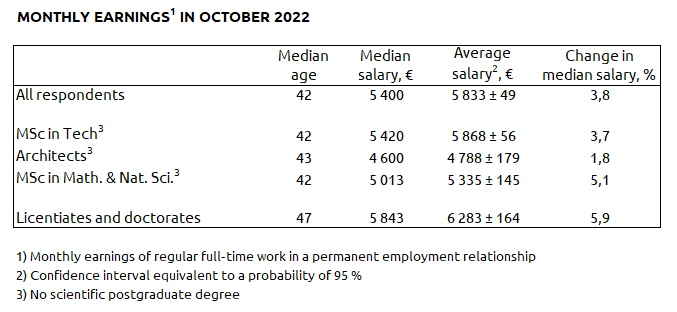
These are tough times, and difficult to predict. The Governor of the Bank of Finland, Olli Rehn, reassured the Finnish government during the September 2021 budget framework negotiations by saying, “Interest rates are not about to rise any time soon, nor are they going to do so in the near future.” Inflation in the euro area was around three percent, and Euribor, the reference rate for euro countries, was negative 0.5 percent.
A little over a year later, his message was completely different. Rehn told the Parliament of Finland’s Commerce Committee last November, “The outlook for the European economy is currently quite bleak,” and the inflation in the euro area was close to 11 percent. At that time, Euribor was already approaching the three percent threshold.
But why should any of this matter to the average TEK member? Well, for example, because TEK members’ purchasing power has weakened due to the general economic developments described above. Even though salaries rose, prices rose even more. This means that the euros you were paid by your employer could not buy you what they used to.
For example, the median salary of an academic engineer increased by 3.7 percent compared to October of the previous year, but according to Statistics Finland, the annual change in consumer prices was 8.3 percent as of October.
What should we think about all this, TEK’s Labor Market Director, Chair of the Federation of Professional and Managerial Staff YTN Teemu Hankamäki?
“Real earnings have fallen considerably, and if this trend continues, it will reduce domestic consumption. This will cause the predicted recession to be even deeper and longer than if the purchasing power of Finnish consumers was maintained at its current level.”
Hankamäki also reminds us that we can’t really do anything about the past, but we can influence the future.
“Mistakes have been made, but I am now imploring businesses to act responsibly. The financial situation of industrial companies is good and the volume of orders is high. Companies can afford salary increases to help maintain purchasing power.”
The median salary of an academic engineer is 5,420 euros
According to TEK’s labour market survey conducted in October 2022, the median monthly salary of an academic engineer in permanent employment was 5,420 euros, and their average salary was 5,868 euros. The corresponding salary figures for academic engineers who graduated in 2022 were 3,836 and 3,875 euros.
Salary development was positive also in other degree groups.
The group that saw the biggest increase in salaries, 5.9 percent, was those with a postgraduate degree, i.e. those with a doctoral or a licentiate degree.
However, in groups with small numbers of respondents, the results are more uncertain, and annual fluctuations in different directions are not uncommon.

A general increase is the most common reason for a salary raise
Of the respondents who worked full-time, 81 percent estimated that their salary had increased from the previous year. 11 percent estimated that their salary had remained the same, and 3 percent said that their salary had decreased. The proportion of those who received a salary increase was higher than the previous year, when three out of four respondents estimated that their salary had increased.
By far the most common reason for a salary increase was a general increase, which 66 percent of respondents whose salary had increased said they had received. 30 percent of these respondents had received a salary increase based on their personal performance, or a so-called merit increase. 13 percent of those who had received a salary increase stated that the reason for the increase was taking on a new position or task with the same employer, and 13 percent had received a salary increase after changing jobs.
The biggest increases come to those who change jobs
The monthly salary of those who received a merit increase had increased by an average of 300 euros per year (median increase). Taking on a new position or task with the same employer had resulted in an average monthly increase of 500 euros, and changing employers had resulted in an average monthly increase of 785 euros. On average, those who had changed jobs received bigger increases than the year before.
In 2022, salary increases of around two percent were paid to employees in several sectors, some of which were part of a general increase and some of which were distributed at the discretion of the employer. However, different kinds of agreements on salary increases may have been made regionally.
Performance pay is most common in industrial jobs
About six out of ten respondents who worked full-time said that they were covered by performance pay. Performance pay is by far most common in industrial jobs. 78 percent of respondents working in the industrial sector said that they are covered by performance pay.
When looking at the respondents’ position in the company, performance pay is more common in managerial than in expert positions. 70 percent of those in a managerial position were covered by performance pay. The figure for those in middle management was 72 percent, and slightly more than 50 percent of those working in an expert position.
80 percent of those covered by performance pay had received a performance bonus in the past 12 months. The share was roughly the same as in the 2021 labor market survey.
The average size of the performance bonus had risen slightly, to 8 percent of annual earnings (median). Relatively, the largest performance bonuses were paid in the industrial sector, where their share was 10 percent.
The employee’s position in the company also affects the size of the performance bonus. The median for the performance bonus was 12 percent for management, 9 percent for middle management, and 8 percent for experts.
How the study was done
Data collection for the labour market survey was carried out in October-November 2022, and the target group consisted of TEK members on the labor market. We received approximately 9,100 responses, and the response rate was about 20 percent. The number of respondents and the response rate were the same as last year.
74 percent of the respondents were men and 26 percent were women. The median age was 42 years. The most common degree completed was that of an academic engineer (Master of Science) (78 percent of respondents). The vast majority of the respondents, 91 percent, worked full-time. 2.2 percent of the respondents were unemployed or laid off, and the share of full-time entrepreneurs was 1.4 percent.
Of the respondents who worked full-time, 85 percent worked in the private sector, and about half of them worked in industry. 96 percent had a permanent employment relationship.
Many thanks once more to everyone who answered the survey!
What topics does TEK study?
We at TEK are constantly researching the field of technology: employment, salaries, equality, and coping with work or studies, for example. We have studied and published information on many themes for years – you are welcome to examine and compare the results using, for example, time series visualizations. Read more about our research: www.tek.fi/research